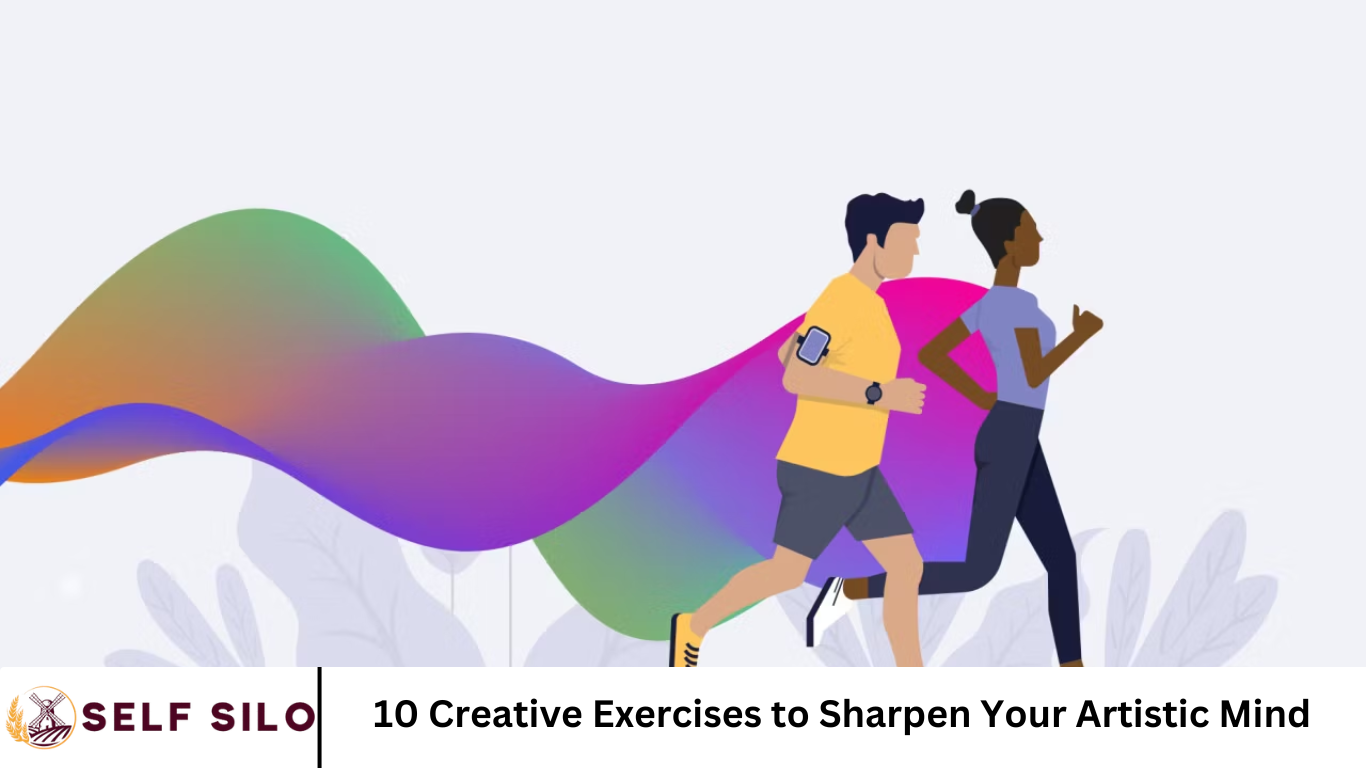Whether you’re a seasoned artist or just beginning your creative journey, regularly engaging in creativity exercises is essential to develop and maintain your artistic skills. These practices help unlock your imagination, enhance problem-solving abilities, and nurture originality.
This article explores 10 powerful creative exercises designed to sharpen your artistic mind and boost your creativity across various mediums.
More Read: The Process: Sketch to Finished Vector Illustration
1. Blind Contour Drawing
Blind contour drawing involves drawing an object without looking at your paper. The goal isn’t to produce a perfect image but to train your eye-hand coordination and enhance observation skills. This exercise forces you to truly see the object in front of you, breaking away from assumptions and symbolic representations.
How to Do It:
- Choose a simple object (your hand, a mug, or a plant).
- Without looking at your drawing surface, draw the object in one continuous line.
- Focus entirely on the object, letting your hand follow your eyes.
Benefits:
- Improves observational accuracy
- Enhances eye-hand coordination
- Encourages mindfulness
2. Daily Sketchbook Practice
Keeping a daily sketchbook builds consistency and encourages creative exploration without pressure. It serves as a visual diary, capturing fleeting ideas, emotions, and inspirations.
How to Do It:
- Dedicate 15-30 minutes each day to sketching.
- Draw from life, imagination, or use prompts.
- Experiment with different styles, tools, and subjects.
Benefits:
- Develops discipline and routine
- Tracks creative growth
- Sparks new ideas
3. Color Limitation Challenges
Limiting your color palette challenges you to be resourceful and creative within constraints. This technique is especially useful for painters, digital artists, and designers.
How to Do It:
- Choose 2-4 colors to work with for an entire piece.
- Mix variations and explore tones and values.
- Focus on composition and contrast.
Benefits:
- Strengthens understanding of color theory
- Enhances composition skills
- Encourages innovation within boundaries
4. Recreate and Transform
Choose a masterpiece or famous artwork and reinterpret it in your own style. This exercise fosters creative analysis and helps you understand artistic techniques through replication and transformation.
How to Do It:
- Select a classic painting, illustration, or design.
- Recreate the piece using your preferred medium.
- Add your own twist: change the setting, characters, or color scheme.
Benefits:
- Deepens appreciation for art history
- Sharpens analytical skills
- Builds creative confidence
5. 30 Circles Exercise
The 30 Circles exercise is a classic ideation activity that promotes divergent thinking. It encourages you to break habitual thought patterns and embrace creativity.
How to Do It:
- Draw 30 empty circles on a sheet of paper.
- In 5-10 minutes, turn each circle into a unique image.
- Don’t overthink—focus on speed and variety.
Benefits:
- Stimulates rapid idea generation
- Enhances imaginative flexibility
- Builds creative momentum
6. Mind Mapping
Mind mapping is a visual brainstorming method that connects ideas around a central concept. It can help clarify thoughts, explore associations, and develop new creative directions.
How to Do It:
- Write a central theme in the center of a page.
- Branch out with related words, images, or concepts.
- Use colors and symbols to enhance connections.
Benefits:
- Organizes complex ideas visually
- Encourages nonlinear thinking
- Sparks interdisciplinary inspiration
7. Switch Mediums
Trying a new medium can reinvigorate your artistic practice and push you outside your comfort zone. It fosters adaptability and opens new expressive possibilities.
How to Do It:
- If you’re a painter, try sculpture or digital illustration.
- Writers can explore photography or collage.
- Focus on expressing the same theme in different formats.
Benefits:
- Expands technical skills
- Provides fresh perspectives
- Breaks creative monotony
8. Collaborative Art Projects
Working with others introduces new viewpoints and ideas. Collaboration challenges your artistic ego and teaches adaptability.
How to Do It:
- Partner with another artist on a joint piece.
- Set rules or constraints for each phase.
- Exchange works-in-progress for feedback or completion.
Benefits:
- Encourages communication and flexibility
- Fosters community and creative exchange
- Sparks unexpected inspiration
9. Dream Journaling
Dreams are rich sources of surreal imagery and narrative. Recording them can offer spontaneous and deeply personal creative material.
How to Do It:
- Keep a notebook by your bed.
- Write or sketch your dreams as soon as you wake.
- Reflect on recurring symbols or themes.
Benefits:
- Taps into subconscious creativity
- Provides unique story and visual prompts
- Enhances memory and awareness
10. Artistic Constraints Game
Creativity thrives under constraints. Invent your own artistic rules or play games that force you to think differently.
How to Do It:
- Choose constraints: only one tool, no erasing, use only shapes, time limits, etc.
- Combine multiple rules for added challenge.
- Reflect on how constraints altered your process.
Benefits:
- Promotes problem-solving
- Sparks inventive approaches
- Builds creative resilience
Frequently Asked Question
What are the best exercises to boost artistic creativity?
The best exercises to enhance artistic creativity include blind contour drawing, daily sketchbook sessions, limited color palette challenges, and collaborative projects. These practices push you to observe deeply, think differently, and experiment fearlessly.
How can I train my brain to be more creative in art?
You can train your brain by consistently practicing creativity exercises such as mind mapping, switching mediums, and using artistic constraints. These methods stimulate different parts of the brain and encourage innovative thinking.
Why is blind contour drawing effective for artists?
Blind contour drawing improves observational skills and hand-eye coordination. By removing visual feedback, it forces you to truly focus on the subject, reducing reliance on symbolic drawing and enhancing accuracy and mindfulness.
How does a daily sketchbook help sharpen artistic skills?
A daily sketchbook builds creative discipline, captures spontaneous ideas, and tracks artistic growth. Regular sketching keeps your skills sharp and encourages experimentation without pressure.
What is the 30 Circles exercise, and how does it help creativity?
The 30 Circles exercise involves turning 30 blank circles into unique images in a limited time. It promotes divergent thinking, helping you break mental blocks and generate a wide range of creative ideas quickly.
Can changing art mediums really improve creativity?
Yes, switching mediums—such as moving from painting to collage or digital art—can refresh your perspective and challenge your habits. It encourages new problem-solving strategies and opens up unexplored creative possibilities.
How do creative constraints improve artistic thinking?
Creative constraints, like time limits or tool restrictions, force you to think inventively and solve problems in unconventional ways. They challenge your assumptions and can lead to unexpected and original outcomes.
Conclusion
Sharpening your artistic mind isn’t about mastering a single technique—it’s about continually stretching your creative limits and embracing experimentation. These 10 creative exercises offer a diverse toolkit for any artist looking to grow, challenge their assumptions, and discover new avenues of expression. Whether you incorporate one exercise or try them all, consistency is key. Make creativity a daily habit, and watch your artistic potential unfold.


